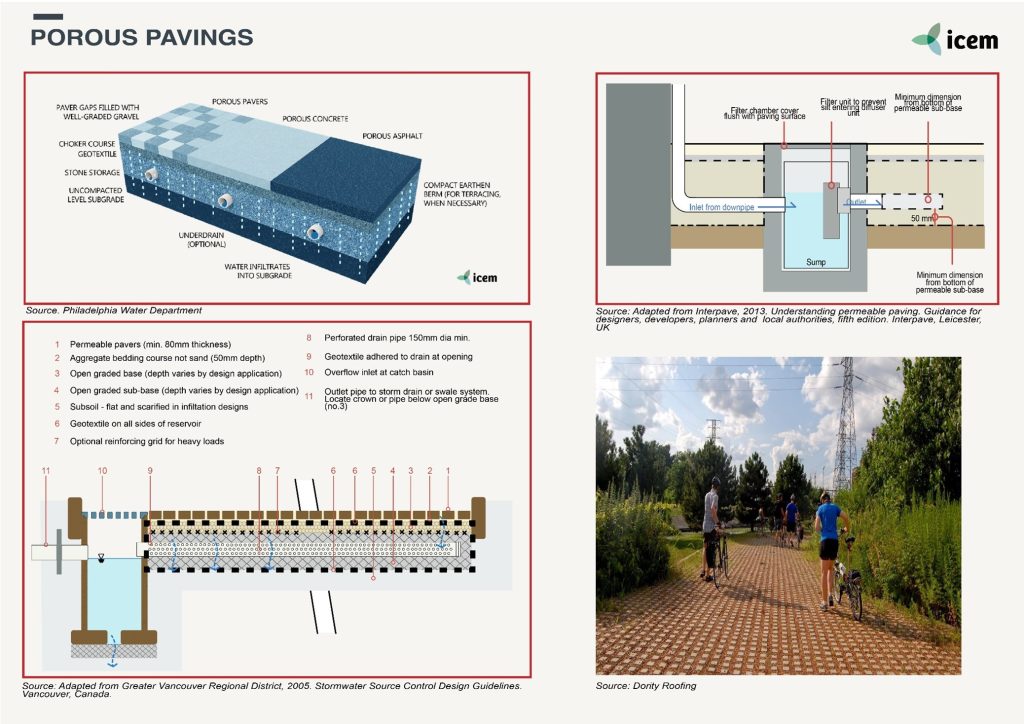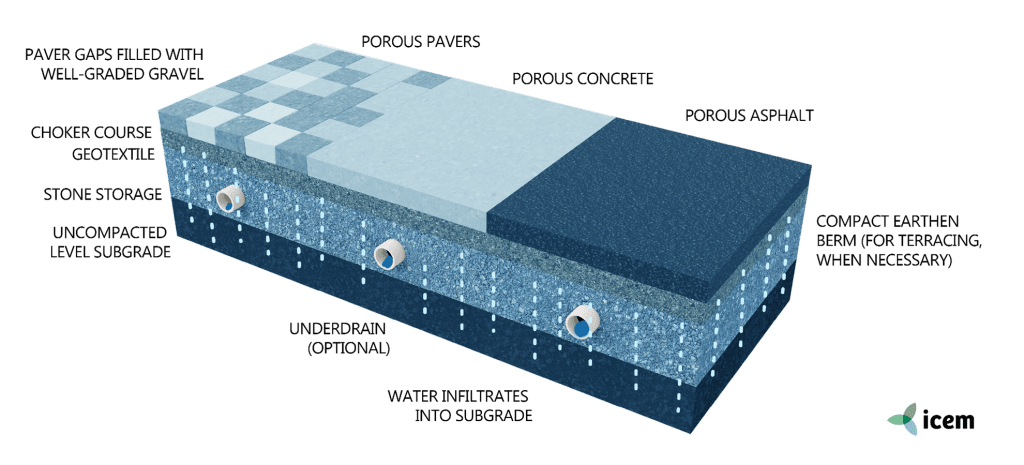| Suburban and urban | Public spaces | Medium-cost | Pluvial/fluvial flooding | |
| DESCRIPTION | |
| Measures
|
Porous (or permeable) pavement includes any type of paving block, asphalt, or concrete that allows water to pass through into a specially-designed sub-grade gravel bed or another porous medium. Porous pavement systems retain water in the subgrade, where it can infiltrate into the ground, evaporate, or be drained from the system. They can be designed for vehicular or pedestrian traffic and are useful in confined urban sites since they have a dual function in that the same space provides for both water retention and vehicular or pedestrian movement. Recent technologies provide a variety of pavement designs, some of which can be planted with vegetation, so they can also add to the aesthetic appeal of a space. Porous pavements can be used to:
● Partially manage the first 2.5 centimeters of rainfall on-site using a grass swale designed to the required geometry and slope to maintain the design volume flow depth and velocity. Grass swales can be used in all hydrologic soil groups; soil amendments can be used to enhance performance in HSGs; ● Reduce pollutant loads to meet water-quality targets; ● Retrofit existing developed areas and existing drainage channels. “Porous surface” refers to pervious concrete, porous asphalt, concrete grid pavers, and permeable interlocking. |
| Location | Porous pavements can be blended into the urban almost any paved surface. Designers often limit the pavement to parking stalls and lower-traffic areas such as roads or nontravel lanes of parking lots. They are well suited to sites with light vehicle weights and low-traffic streets in residential and commercial areas as well as footpaths, driveways and parking bays. Porous pavements are subject to clogging particularly in locations with high sediment loads where pre-treatment may be required to minimize the potential for clogging. They are also not suitable in situations with high traffic loads. |
| Design options and performance | There are two main categories of porous pavements: (i) Porous surfaces comprising a layer of highly porous material such as specially designed concrete or asphalt and (ii) permeable pavements comprising a layer of interlocking paving blocks either made with porous material or specially shaped to allow water to pass through vertical slots to the underlying subgrade.
|
| Feasibility criteria
|
Available space: A prime advantage of permeable pavement is that it does not normally require additional space at a new development or redevelopment site, which can be important for tight sites or areas where land value is high.
Site topography: Steep pavement surface slopes can reduce the stormwater storage capability of permeable pavement and may cause shifting of the pavement surface and base materials. Designers should consider using a terraced design for permeable pavement in sloped areas, especially when the finished parking grade will be 3% or greater. External drainage area: The area of pavement draining onto “run-on” a permeable pavement section should be limited to twice the area of permeable pavement. The external drainage area should be as close to 100 percent impervious as possible. Setback: To avoid the risk of seepage, permeable pavement practices should not be hydraulically connected to structure foundations. Setbacks to structures vary based on the size of the permeable pavement installation: ● 20-100 square meters of permeable pavement: 1.5 meters if down-gradient from the building; 7.6 meters if up-gradient ● 100-1000 square meters of permeable pavement: 3 meters if down-gradient from the building; 15 meters if up-gradient. ● More than 1000 square meters of permeable pavement: 8 meters if down-gradient from the building; 30 meters if up-gradient. A minimum, permeable pavement infiltration design or infiltration sump design applications should be located at a minimum horizontal distance of 30 meters from any water supply and at least 1.5 meters down-gradient from dry or wet utility lines. Permeable pavement sizing for larger storms (local detention criteria): Permeable pavement can also be designed to address, in whole or in part, the detention storage needed to comply with channel protection and/or flood control requirements. It should be noted that all site designs should include provisions for the safe conveyance of larger flows, either contained within properly sized pipe or channel systems or as overland flood routing to a receiving water body, to minimize public safety risks and property damage. Pre-treatment: The best pre-treatment technique for permeable pavement is to limit the CDA to the pavement. Traffic will carry particulate pollutants onto the pavement section, and the pavement itself is subject to wear and will create its particulate load over time. Landscaped areas and lawn-cutting operations will potentially mobilize a high concentration of organic particulates that can contribute to pavement clogging as well. Technical design: The design process will include the following steps; (i) pre-treatment design, if required (leaf and litter traps, buffer strips etc. (ii) determination of design flows and vehicle loadings, (iii) checking the emptying time of detained water volume after rainfall stops, (ii) specify the under-drainage design, porous pavement layers and bedding structures and (v) size the overflow pit/ pipework. Other design considerations are: ● Infiltration will be impacted if the in-situ soils are impermeable. Performance can be improved by creating below-ground storage using a deeper gravel drainage layer to increase storage and slow infiltration. ● Porous pavements are not suitable in locations with heavy traffic and high sediment loads. ● To avoid clogging the materials used should satisfy filter criteria which prevent movement of fine sediment between the bedding layer and drainage layer. ● Overflows or surface flows (i.e. flows more than the storage capacity, under drainage capacity and/ or infiltration capacity) should be diverted towards the stormwater system. ● The surface of the porous pavement should be flat or near flat to ensure uniform distribution of flow and to prevent hydraulic overloading on a small portion of the surface. ● In trafficked areas, the design will have to consider the expected vehicle loads and demonstrate the structural integrity of the pavement to a standard consistent with traffic regulations. Soil media: n/a Soil slope: Generally, porous pavements should be on a slope of less than 3% and should not be considered for slopes greater than 5%. Surface cover: n/a Materials: Porous pavements are comprised of four layers: (i) the permeable surface constructed from paving blocks (whether it is the porous pavement itself, or the permeable areas between pavers) (ii) an underlying bedding layer 30 mm thick comprised of 2- 5 mm coarse sand (iii) a drainage layer of 10 mm single sized aggregate (100 to 150 mm thick) with a built-in under drainage system if required and (iv) subgrade material with thickness based on storage volume requirements, but storage volume should be one-third of compacted aggregate volume. |
| Operation and
maintenance |
Porous pavements require regular maintenance since they are susceptible to clogging. The level of maintenance will depend on the type and frequency of usage but can be in the form of deep pore suction cleaning and vacuum sweeping. |
| Cost and benefits | Porous pavements are a low to medium-cost measure. The main benefit that they provide is the increased infiltration of runoff water into the underlying soils thus minimizing the volume of stormwater entering downstream stormwater systems and receiving water bodies. If implemented on a large scale in an urban environment the size of the stormwater network will be reduced, resulting in substantial savings. |
| Design
solution |
Every year an increasing load is placed on already overloaded drainage systems and there is increased stress on water treatment systems and receiving watercourses from pollutants. Permeable paving is a relatively recent introduction as an alternative to paving, but it will have an increasingly critical role in the future for towns and cities. It is one of the key technologies behind WSUD as it enables control of stormwater at its source. Permeable paving systems are available in a wide variety of technologies and can be more cost-effective than traditional paving systems which collect and convey runoff. They also offer significant environmental advantages, such as the natural breakdown of pollutants, replenishment of aquifers, and the possibility of water harvesting. |
| Environmental performance | The environmental benefits of using porous paving material derive from its ability to allow rainwater to infiltrate through the surface and into the pavement’s underlying structural layers where it can be temporarily stored, before being infiltrated into the ground or discharged downstream. Stormwater is therefore managed at its source by intercepting the runoff, reducing the volume and frequency that enters the drainage network and providing a treatment medium. The treatment processes that can occur within the sub-surface structure, including the soil layers where infiltration is allowed, include filtration, absorption, biodegradation and sedimentation. The direct environmental advantages, therefore, include the natural breakdown of pollutants, replenishment of aquifers, and the possibility of water harvesting. |
| Sources | ● CIRIA. 2015. The SuDS Manual. Chapter 20, Pervious Pavements.
● Pennsylvania Stormwater. 2006. Best Practice Manual – Chapter 6: Constructed Wetlands. ● Organica Engineering, 2020. A guide for water sensitive urban design – Stormwater management for small scale development. |
Originally developed under the ADB ‘TA-9417 VIE: Secondary Green Cities Development Project – Output 2: Demonstrated sustainable and resilient development in Hue, Ha Giang and Vinh Yen’. Adapted for the UN-CTCN project ‘Climate risk assessment for subnational adaptation and establishment of a local climate information system for climate change adaptation (LISA) in Cambodia’.




